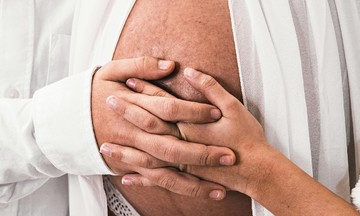Minh experienced a miscarriage at 11 weeks during a natural pregnancy. She and her husband then underwent four unsuccessful in-vitro fertilization (IVF) cycles at another hospital, despite preimplantation genetic testing (PGT).
At the Fertility Center of Tam Anh General Hospital in Hanoi (IVF Tam Anh), Dr. Cao Tuan Anh diagnosed Minh with ovulatory dysfunction, making it difficult for eggs and sperm to meet for fertilization. Her uterus also had abnormalities, including adhesions and a septum, hindering embryo implantation and increasing the risk of miscarriage, premature birth, or fetal growth restriction.
For their 5th IVF attempt, Minh received a personalized ovarian stimulation protocol, reducing the number of injections to minimize the risk of ovarian hyperstimulation syndrome. Her husband's sperm was processed and injected directly into the egg's cytoplasm (intracytoplasmic sperm injection or ICSI) to create embryos. These embryos were cultured in a time-lapse incubator, allowing continuous monitoring for any abnormalities during cell division. The incubator's temperature, pH, humidity, light, air quality, and concentration were optimized to mimic the natural environment, enhancing embryo viability. The couple obtained three high-quality day-5 embryos, which were then cryopreserved.
Minh underwent surgery to remove the uterine septum, address the adhesions, and reconstruct her uterus to create a more suitable environment for embryo implantation and growth. A day-5 embryo was transferred, resulting in pregnancy, but unfortunately, it ended in another early miscarriage.
 |
Dr. Cao Tuan Anh consults with a couple. Illustrative photo: Trang Le |
Two years later, Minh returned to IVF Tam Anh to transfer the remaining frozen embryos, but without success. With no more embryos in reserve, they began a new IVF cycle. This time, they retrieved only one day-5 embryo, which tested normal after PGT. If this single embryo transfer failed, they would have to start the entire IVF process again.
To maximize the chances of success, reduce treatment time, and minimize costs, the doctors meticulously planned a personalized endometrial preparation protocol before the embryo transfer. This time, Minh became pregnant but went into premature labor, delivering a baby girl at 29 weeks. After a month in neonatal intensive care, the baby was discharged, weighing 2.3 kg.
"I named my daughter Tam Anh to express my gratitude to the doctors who helped me become a mother," Minh said.
In early 2025, the couple returned to IVF Tam Anh to try for another child. They retrieved two day-5 embryos, both genetically normal. Minh is currently around 14 weeks pregnant and her pregnancy is progressing well.
Dr. Tuan Anh emphasized that embryo culture and quality monitoring are crucial in IVF. Advanced reproductive technologies like ICSI, PGT, autologous platelet-rich plasma therapy, egg and sperm freezing contribute to higher success rates for couples struggling with infertility, while also reducing miscarriages and terminations due to birth defects. In 2024, the cumulative pregnancy rate at the IVF Tam Anh system averaged 78.7%, including many cases involving older women, multiple failed IVF cycles, and complex medical histories.
Trinh Mai












